► New Alfa Romeo Giulia Quadrifoglio tested
► Is it the return to form that was always promised?
► We test regular 2.2-litre diesel, too
Alfa Romeo’s Giulia Quadrifoglio is a story of a race against time. A race to get a brand new car from drawing board to market in less than three years. A race to get it round the Nürburgring Nordschleife faster than any other production saloon car on the planet. A race for me to vaporise a brand new set of Pirelli P Zero Corsas in the best Alfa I’ve ever tried before I’m dragged kicking and screaming from the driver’s seat. And most of all, a race to remind the world that Alfa Romeo still knows how to make a proper driver’s car while there’s still anyone around who actually cares.
People who remember Alfa’s glory days are like people who remember when Chevy Chase was funny. Few, elderly and probably suspected by most everyone else of making the whole thing up. Even the 156, that last truly competitive Alfa saloon, was launched almost 20 years ago, and Alfa hasn’t even had a mid-sized car in its line-up since the handsome but ho-hum 159 got its draft papers from the Reaper back in 2012. What about the 8C, you say? Pretty, but vacuous. And the 4C? Not as good as a secondhand Elise and twice the price. That’s why today we’re driving not only the bread-and-butter Giulia diesel, but the red-hot Kwah-dree-foh-lee-oh too. Alfa wants to ram home the message that it’s finally serious about doing its badge, its heritage and its long-suffering fans justice.
The hottest Giulia is gunning for Germany and made headlines there when it took 13sec out of the BMW M4’s ’Ring lap time last year, lapping the forest circuit in 7min 39sec. But this time we’re on Alfa’s home turf. The Balocco test facility, an hour’s drive west of Milan on the A4, and a similar distance from Turin in the opposite direction, has Fiat’s name on the deeds, but Alfa’s genes. Built in the 1960s during Alfa’s heyday as an independent carmaker based close by in Arese, this was where the original Giulia sports saloons did their shakedown testing. And the Spiders, the GTVs and Berlinas. The race cars too. Standing among the old buildings listening to the sound of a Quadrifoglio tearing around the outer track you can imagine Autodelta boss Carlo Chiti eyeing a stopwatch as mechanics tweaked a GTA, TZ3 or Tipo 33 before sending the cotton-suited driver out for another run.
We walk down a narrow path to a kind of pit-stop garage-cum-lecture-theatre. Tiered steps parallel to the road running through the hugely tall garage structure give it the feel of a Barrett Jackson auction. Sheltering from sweltering May sunshine, five Giulias sit waiting our attention: three diesels and a pair of stunning red QFs.
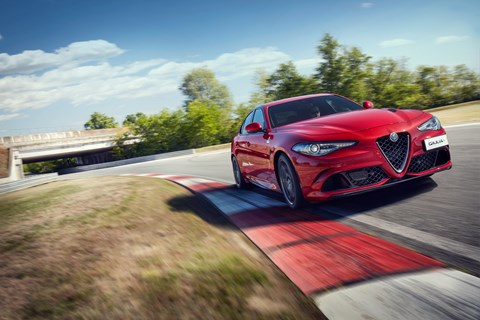
Like I’ve just stumbled unwittingly onto a nudist beach and am trying to pretend it’s all so normal I summon all my willpower not to look at the good stuff and dutifully check out the oil burners first. Even minus the QF’s baubles they look the part. Designed in-house by a team under ex-Pininfarina man Lorenzo Ramaciotti, the Giulia is not as striking as the 156 was back in ’97 and there’s still something weak about the front 4 end: the lights lack the menace of the 159’s and the way the bonnet no longer stretches to the grille, but stops short, is a sop to crash repair that leaves it looking like the lid of an old top-load washer. But it’s low and elegant in the way the Giulietta hatch is not, distinctive and, pleasingly, not a German clone.
That’s enough lip service. We all know why I’m there and you’re here, and it isn’t to read about sub 100g/km fleet champs (though you can on page 63). The Quadrifoglio takes the Giulia and swells, stretches and sucks it in every direction, pushing its surprisingly modest 19in wheels to the very edge of the arches. An iconic triangular Quadrifoglio Verde badge is recessed into each wing, a cheeky nod to the Ferrari heritage we’ll come to shortly, and at the rear four huge exhaust tailpipes are framed by a gigantic diffuser. Those pipes are real, not fake bumper-mounted chrome trims. The vents in the bonnet and wings are functional too. For ex-Ferrari 458 engineer Philippe Krief – hand-picked by Sergio Marchionne to rescue the floundering Giulia project – authenticity and credibility go hand-in-hand. And authentic, for Marchionne, meant ditching the original front-drive plan for a ground-up rear-wheel-drive platform.
If the Giulia looks promising from the outside, a delve under the skin offers no disappointments to make you question the likely £60k price. The body is constructed largely of steel but uses aluminium for the front and rear doors, bumpers, wings, suspension and rear crossmember. The rear crash structure is made from aluminium and a plastic composite, and the propshaft is carbonfibre. And that’s just the cooking version. To that list the Quadrifoglio adds a composite roof, bonnet, rear spoiler and active front splitter. And a whole lot more muscle.
Alfa talks about the Quadrifoglio’s twin-turbo engine being all new, but it shares DNA with the F154 Ferrari-Maserati family, including the 90-degree vee and 86.5mm bore common to the 488, California and Quattroporte S. But instead of their eight cylinders and 3.8 or 3.9 litres, the Alfa makes do with six and 2.9. Not that output seems to have suffered much. Okay, so its 503bhp is significantly less than a 488’s 661bhp, but it matches an AMG C63S’s best efforts (the ordinary C63 makes a piddling 469bhp) in a package that weighs over 100kg less.
Why go to all that trouble when the Maserati Ghibli S’s V6 already produces over 400bhp? Couldn’t they just have liberated a bit more boost and slotted that under the Giulia’s bonnet? Not according to the people who know.
‘The Maserati V6 is a 60-degree V6 so it doesn’t sit as flat,’ says an engineer. ‘And it wasn’t capable of the power we needed anyway. This engine is better for packaging and gives us plenty of room to push the power even further later on!’
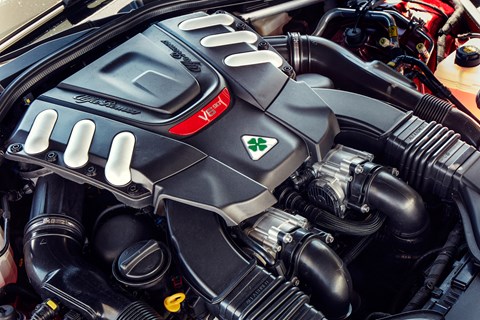
It’s not only the design of the engine that’s influenced by Ferrari. So is the way you start it. The steering wheel feels fabulous, and looks almost as good, the handsome monotone Alfa badge at the centre of a massive retro hub fighting for your attention with a very Maranello-styled red starter button dangling beneath the left-hand spoke. Gleaming red against the relentless menacing blackness of the rest of the cabin, like a redneck street brawler’s eye, it’s begging for a thumbing. Don’t mind if I do.
Thirty seconds later I’m deep into third gear, right pedal pinned and watching the rev counter needle head for the redline like a naked flame chasing down a trail of petrol. Alfa says 0-62mph takes just 3.9sec, making it as quick as an AMG C63S, almost half a second faster than a BMW M3 and over one second niftier than a Ghibli S. Yeah, I’m starting to see why the Maserati engine wasn’t in the tool kit.
The V6 is an animal: urgent, angry and astonishingly free from turbo lag. Prod the throttle and there’s the merest pause, almost a courtesy to you to let you prepare for the barrage on the way. And then it’s off the leash and running. It’s fitted with a traditional crossplane crank rather than the 180-degree type you get with a Ferrari, but it chews through the revs like you wouldn’t believe. And unlike so many turbo engines, it keeps on pulling, not serving its 443lb ft up in one great dollop, but willing you on to kiss the 7400rpm redline again and again, before tugging the shift paddle and dropping in another ratio from the ZF eight-speed auto that’ll be the only transmission available in the UK.
Long, slender slivers of satisfyingly cool-to-the-touch aluminium, those paddles are straight out of the supercar how-to book right down to the way they’re mounted: fixed to the column, not the wheel, so you always know which one to pull to grab the next gear no matter how out of shape you get. And believe me, you’re going to get out of shape on a baddie-from-Terminator 2 scale.
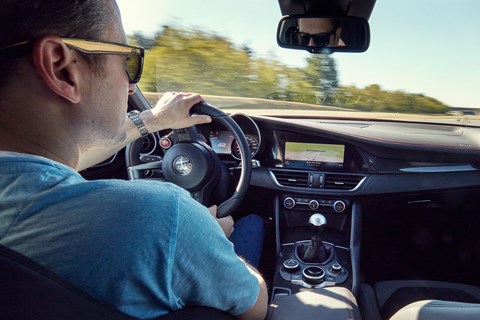
But only because you’ll choose to. Some credit must go to the sticky Pirelli P Zero Corsa tyres, some to the modest torque output, and probably another share to the torque-vectoring rear differential, but the QF feels far more stable than a BMW M3 or AMG C63. It lets you lean hard on the double-wishbone front end into the turn, then load up the rears with a big squeeze of right foot and still keep everything together.
The brakes are incredible too. Out of the long, long fast left- hand corner at the north of the track there’s a b-i-g straight, a one-mile stretch that lets you unwind the QF towards its 191mph claimed maximum before piling on the middle pedal for a 90-degree left-right combo. It’s a huge test, but the solid feel underfoot of the six-pot Brembos chomping down on a couple of composite dinner plates is more than just talk. 4
The steering is hyper-responsive through the section that follows, letting you pick a turn-in spot down to the blade of grass on the track’s edge. But it’s a touch light and feels more reassuring with the added heft that comes with a twist of the console DNA selector from Normal to Dynamic mode. That also opens the exhaust valves for a little more engine noise, sharpens the throttle and stiffens the dampers, although as on a Ferrari you have the choice of softening them off again via a button in the centre of the DNA dial.
You can consider Dynamic the defacto base setting, but to really hear the V6 sing you need to squeeze the dial round against its spring to Race, an extra position not offered on the ordinary Giulia. Which, for some owners, means chancing an off-road excursion because Race mode also disengages the ESP.
It seems odd that Alfa has chosen to play it extra safe with the cooking Giulia, making the ESP non-switchable, yet only allows you to hear the full engine sounds in the QF by selecting a mode that also leaves you flying without an ESP safety net. I can imagine plenty of buyers feeling distinctly uncomfortable at the prospect of driving their new £60k car with no ESP backup, and miffed that it’ll mean a more muted experience.
A separate ESP button to engage and disengage the ESP in Race is all that’s needed. Heaven forbid that Alfa should decide to deny those that are happy to fly solo the chance to experience the QF off the leash. Because it’s genuinely brilliant fun. Poised and biddable, happy to dance around on the brink of a slide, and equally content to go deliriously deep into the sort of angles that’ll have you turning your head round like an owl to see where you’re going and leaving everyone else choking on a rooster tail of fried Pirellis.
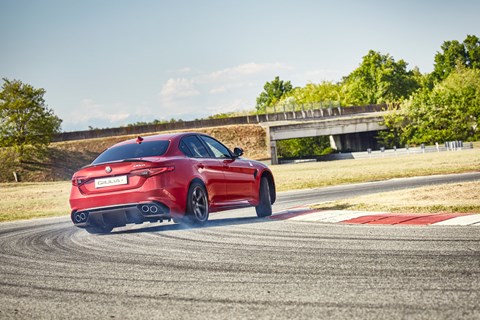
Today we’ve been confined to the flattering smooth tarmac of test track. We can’t make any judgements on ride quality, or wet weather ability until we get to try one on UK roads in the autumn. But we’ve seen, heard and felt enough to know there are unlikely to be many disappointments when that does happen. The Quadrifoglio isn’t merely good, it’s good enough to make you think very hard about how exactly its German rivals might persuade you not to buy one over them.
Back at the garage, and still reeling at the realisation that they’ve only gorn and bloomin done it, I get time to poke around the rest of the package while snapper John is busy taking pictures. From the minute you slide behind the wheel it’s clear Alfa has put effort into getting the basics right. The seat winds way down into the floor and the wheel telescopes right out so you can play at being Gabriele Tarquini – I’m thinking more 4 his Silverstone win than his Knockhill barrel roll – though once you’ve clapped eyes on the optional carbon-backed buckets, the excellent standard chairs will seem distinctly disappointing.
There’s more than a hint of Audi in the bright white lighting and type-face of the twin-dial instrument pack, and the widescreen multimedia display, hidden neatly behind a flush black screen and operated by a rotary controller on the column, is clearly influenced by the German segment leaders. We’d by lying if we said the overall fit and finish was class-leading stuff. Both Merc’s C-class and the A4 feel more special, but it’s at least as good as a BMW 3-series to the touch, better than a Jag XE, and vastly more imaginative than either.
And it does at least feel genuinely sturdy throughout. Well, almost throughout. Ironically, given Alfa’s historic reputation for unreliability, the flimsiest bit of trim on the whole car is in the most unlikely place. The bonnet release catch feels like it’ll only last a handful of pulls before snapping in your hand. Is that disastrous penny-pinching or an indication of Alfa’s supreme confidence in its reliability to the extent that it thinks you should never have to lift the lid? I can’t decide.
But I have no problems deciding which version of the Quadrifoglio is the best. Before we go I get a chance to drive a QF with the manual transmission, an option Brits don’t get because the right-hand-drive engineering costs didn’t stack up, to see what we’re missing. The answer is much less than you’d think. It’s a Getrag ’box (cooking manual Giulias that we also don’t get in the UK and weren’t able to drive, use a ZF) with six speeds to the auto’s eight, but the engine’s torquey, low-lag character covers the gaps.
Even in Race mode there’s no auto-blip rev-matching software, so you’ve got to do it the old-fashioned way, just like the test drivers would here at Balocco back when the track was new. The footwork is no chore. The brake feels firm and the throttle pedal extends right down to the floor so you can either cover both with the ball of your right foot or keep it on the middle pedal and flick out your heel to throw on some revs before snicking the next gear home.
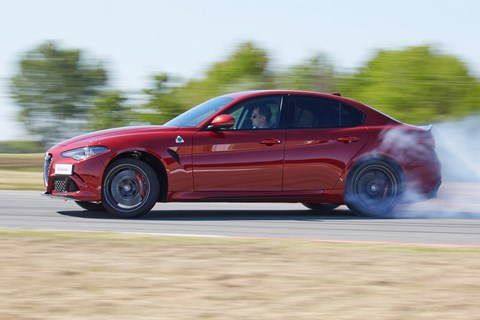
But the gearknob feels large in your hand and the join between the upper and lower sections annoys. Strange, when the same people managed to get the steering wheel so right. Worse, the shift itself feels slightly clunky, demanding tongue-out-of-side-of-mouth levels of concentration to make smooth progress. The test car’s ’box sounded a little noisy too, although that could be down to it being a pre-production car. Whatever. Let’s lose no sleep over being stuck with the auto. It’s a much better car minus a pedal and you get to fondle those paddles as often as you like.
And you will like. You’ll like almost everything about the Quadrifoglio. Here’s an Alfa Romeo we can praise without falling back on character, charm, soul or any of those other words that basically mean here is a car that’s really pretty rubbish when we really wanted it to be good. That’s not to say it doesn’t have charm, soul and character, because it does. But this time it backs it up with proper dynamism, technical excellence and class-competitive build quality. It’s head-meets-heart without causing a pain in the neck. It’s the first great Alfa in too long. Let’s hope it’s the first of many.
Alfa Romeo Giulia Quadrifoglio
Engine: 2891cc twin-turbo V6, 503bhp @ 6500rpm, 443lb ft @ 2500-5500rpm
Transmission: Eight-speed auto, rear-wheel drive
Performance: 3.9sec 0-62mph, 191mph, 33.2mpg, 198g/km CO2
Weight: 1624kg (est)
Price: £60,000 (est)
On Sale: Autumn
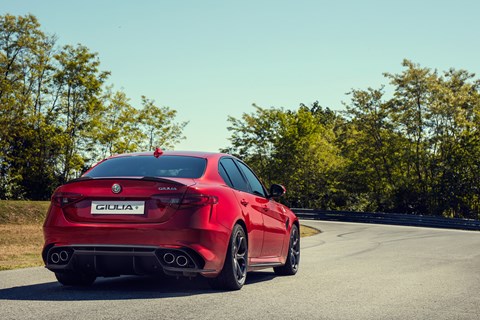
Giulia vs its rivals
Alfa Romeo Giulia Quadrifoglio
> Price: £60k
> Engine: 2.9 V6 turbo
> Power/Torque: 503bhp/443lb ft
> Stats: 3.9sec 0-62mph, 191mph
> We say: Best Alfa in a generation
BMW M3
> Price: £56k
> Engine: 3.0 6cyl turbo
> Power/Torque: 425bhp/406lb ft
> Stats: 4.3sec 0-62mph, 155mph (ltd)
> We say: Rowdy, but not an M classic
Mercedes-AMG C63 S
> Price: £67k
> Engine: 4.0 V8 turbo
> Power/Torque: 507bhp/516lb ft
> Stats: 4.0sec 0-62mph, 155mph (ltd)
> We say: Lairy lout meets heavy limo
Once more with diesel
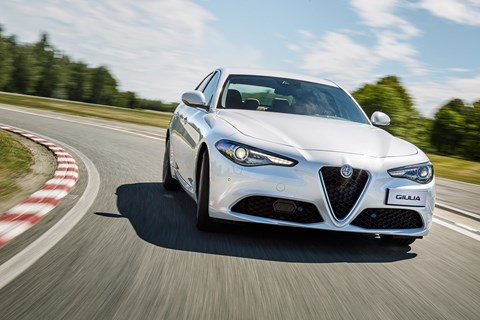
Hot Alfas can always entertain, but it’s in the diesel-powered company car market that Giulia will live or die. Can Fiat’s new diesel engine cut it?
The Quadrifoglio proves to the world that Alfa still has the ability to make a proper driver’s car, but it won’t do Alfa’s bottom line any good. That’s the job of the ordinary Giulia. We’re not expecting QF-style fireworks from a fleet car, but does some of that DNA carry over?
The UK-market range consists of just two engines, a 2.0 petrol with 197bhp and the brand new 2.2 diesel, in 148bhp or 178bhp tune. We tried the latter. The entry-level car is called simply Giulia and comes with 16-inch alloy wheels, dual-zone climate, cruise control and a suite of safety systems – including lane departure warning, collision warning and autonomous braking.
Super adds navigation, part leather seats, 17in wheels and rear parking sensors, while optional Sport and Lusso packs bring further kit yet to be determined for UK cars. Prices are TBA, but expect them to match a 3-series (ie, starting in the high £20ks) while offering more standard kit.
As with the QF, other markets get the choice of manual or automatic transmissions, while we’ll have to make do with the auto. Fortunately it’s a good one, ZF’s eight-speed, and tweakable via the same gorgeous metal shift paddles fitted to its hot brother. The driving position is equally good, the interior quality solid, if not quite up to Audi A4 standards, and head and legroom is up to par front and rear.
A thumb push on the Ferrari-style starter button confirms that the Audi’s diesel is more refined than this new Fiat motor. The Alfa sounds muted at a cruise, its common-rail chatter drowned out by the noise of air fighting its way past door mirrors mounted at just the right height to obstruct traffic at junctions.
The engine is redlined at 4500rpm, but sounds harsh by four. Far better to shift early and surf the wave of torque. There’s plenty. With 187bhp and 332lb ft the Giulia outpoints its key rivals for twist, and matches them on power and performance, cracking 62mph in 7.2sec while also promising 67.3mpg and as little as 99g/km in Eco form.
It feels lively through the bends too. The steering seems overly light at first, but better as speed builds, and you inevitably switch the DNA drive-mode selector to the sportiest setting. It’s quick at 2.3 turns between the stops and turns the nose with urgency, the body staying relatively flat until you really start pushing. Do that and the front end runs wide while giving you no option of using that 332lb ft to edge the rear tyres out to compensate. You can’t switch out the stability system. Instead the rear-drive layout reveals its character in other ways: an excellent turning circle, unbeatable traction and the balance that comes from a 50:50 weight distribution.
Are we looking at a new class champ? Probably not – others have the premium and refinement angle better covered – though only a proper drive away from the confines of Fiat’s test track will confirm it. What matters is that the Giulia is a properly credible rival to established opposition. This is an Alfa that will sell on merit, not just the name.
Alfa Romeo Giulia 2.2D
Engine: 2200cc turbodiesel 4cyl, 178bhp @ 3750rpm, 332lb ft @ 1750rpm
Transmission: Eight-speed auto, rear-wheel drive
Performance: 7.1sec 0-62mph, 143mph, 67.3mpg, 109g/km CO2
Weight: 1449kg
Price: £30,000 (est)
On Sale: Autumn
Read more from the April 2016 issue of CAR magazine